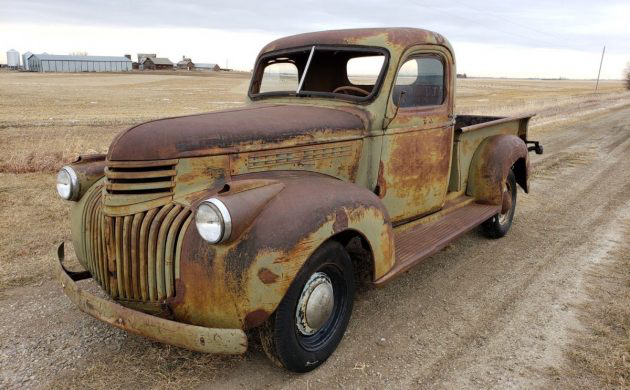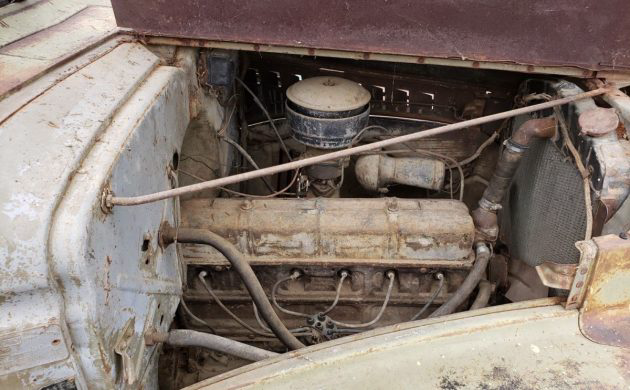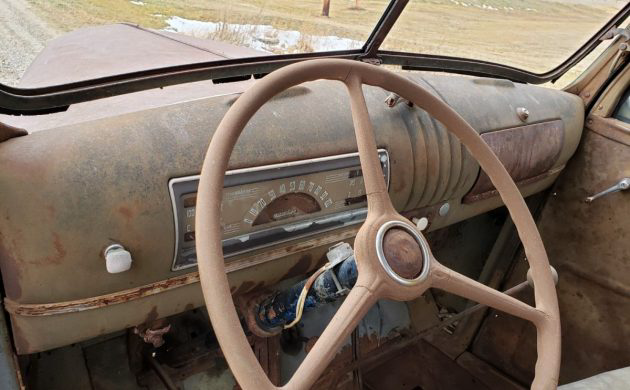Painted in war paint, but thought to be a civilian model pickup, this Canadian built pickup is a cool find. Its wartime era appearance and its solid cab and bed make it a prime example for restoration. With 6 days remaining, bidding has reached $2,269. Check out this war era pickup here on eBay out of Sweet Grass, Montana.
The 216 inline 6 appears quite complete, and not too shabby for a long nap. Virtually bulletproof, I wouldn’t be surprised if this old 216 still has a little life left. There appears to be no rot in, near, or around the engine compartment. Otherwise, we know little about the drivetrain’s condition.
Despite the missing front windshields, the interior isn’t as shabby as you would think. There is still paint on the dash, and the gauge cluster is still in place. Upholstery work will be needed, but miraculously the floors look to have aged quite well displaying only surface rust.
Although there is certainly a fair amount of surface rust, this old pickup is quite solid. The cab corners and the door sills are very nice. In fact, the only area of rot appears to be the lower section of the passenger side door. There are a couple of dents in the rear fenders, and there is a small patch put over a small sheet metal rip on the passenger rear fender. Both the front and rear glass is missing, and the wooden bed is long gone, as is the rear bumper. A great start to a cool truck for sure. Would you revive this war era Chevy?











They just keep on coming and that’s just fine with me! A restoration would be in order but it would be worthwhile; a pickup of this vintage is about as rare as it could be. I’m very surprised that someone could get a permit to buy a new pickup; 3-ton trucks took forever as it was during the war. I’d keep the 216; it would take me all the places I ever wanted to go, and do my hauling too.
A 1942 truck could well have been assembled in the last months of ’41, and might have gone to its first owner before December 7th of that year. Perhaps some research-minded enthusiast could figure that out from the serial number….
The cool factor is high enough that I wouldn’t even care about relative rarity. I’d want to restore, and then drive.
It’s a Canadian made vehicle and Canada was in WW2 over two years before Pearl Harbour. The Chevy 3 ton was made as service for the RAF and RCA F in Oshawa Ontario. This one likely saw war service in Canada then was sold off for civilian use after the war. General Motors has recently announced the closing of that plan after over 100 years of producing automobiles.
Again with the Sweetgrass, new found Mecca for old trucks? I think this was the standard take it or leave it, “bugs in your face” model. Hey, everyone needed to make sacrifices for the war. I read, there was a form you could fill out, and get one of the trucks that was stockpiled before the war, which dwindled quickly, but it said, no new trucks were sold to civilians during the war.
Hi Howard. My uncle had just taken on a Chrysler/Plymouth/Dodge truck franchise before the war broke out. I remember Dad talking that after February of ‘42, any new leftover stock was sold under permits, and a lot of floor planned stock got transferred out from under your nose. Uncle Woody sold ONE new truck in ‘42, and that (a 3-ton) was to a water well driller. He sold maybe 10 more by the end of the war. Dad said that they came in with the dual tire rims but the extra tires had to be scrounged. The border region was a haven for black market products from both the US and Canada, with tires being a premium. Uncle Woody sold several lines of tires, being on the border, he was privy to some ‘deals.’ But by the middle of ‘43, there was a contingency of federal marshals parading through his place. About all they accomplished was to drink a lot of coffee.
Dad had one of these models in a 2-ton grain truck. I’m sure I remember something in the owners manuel- paper work about it being purchased during the war years,should still have that stuff some where.
This truck looks cool the way it is, I would just fix the mechanicals and drive.
Wow! Up to four grand plus already!
I like these early GM half tons alot but……this one has been sitting out in the back forty for a very long time…….there’s nothing this won’t need….as in a complete rebuild from the tires up…….it’s a long way and more money than one would think from being useful….but I guess if you have the money and the time, what else could you spend fifteen or twenty grand on!
I am skeptical of the claimed 1944 civilian model. US automobile production ceased by February 1942 and did not resume until October 1945. It is difficult to find information on Canadian automobile production during WWII, but seeing that corporate GM (along with the other major auto makers) converted factories to wartime production needs it is doubtful they continued to make civilian models in two plants in Canada.
https://www.teachinghistory.org/history-content/ask-a-historian/24088
I own a restored 41 half ton and this is likely a 41. For what it’s worth, here is what I see –
The door lock was in the door handle in 41 and was moved down into the door in 42 and 46. I don’t see a door lock in the door below the handle, making at least the door a 41 door. The 41 half ton trucks have AK in the serial number, while 42 trucks are BK. If this has a tag that says AK it is a 41. Even if you assume this was wartime production, and was sold in 44, I think this would have been a BK model.
It does have the original rear fenders, which are hard to find, and seems to be pretty complete. Most parts are relatively easy to find. Surprisingly the hardest part for me to find was the spare tire holder under the bed. It weighs more than the tire, and I think most people threw them away the first time they had to get the spare out. The parking lights on the headlight pods are incorrect for 41. They are a two piece unit in 41, and single piece unit in 42 and 46. These are beautiful when restored, and this one looks complete.
The original 216 stovebolt 6 had poured babbitt bearings and splash oiling, so if you need to rebuild this one and want a better engine but want to keep the same engine look, get a 235 from after 1953. They also make a 3:55 rear end ring and pinion that drops right into the existing axle and lets you use the truck at higher speeds.
Canadian manufactured trucks don’t have AK or BK in the VIN. I have several of these trucks in Canada. One being a 43 very similar looking to this. Civilian 43 and 44 Canadian produced trucks aren’t terribly uncommon. All Canadian produced trucks had the 2 piece headlamp/marker lamp units, including my maroon 46 3/4 ton that’s been on the farm since new. There’s a lot of small differences between 40s/50s Ford and Chevy trucks based on if they were built in the US or Canada. The VINs are completely different. Unfortunately there is minimal documentation on the Canadian manufactured trucks.
Get it running and safe, some seat covers and clear coat and off I go. Love it as it sits!